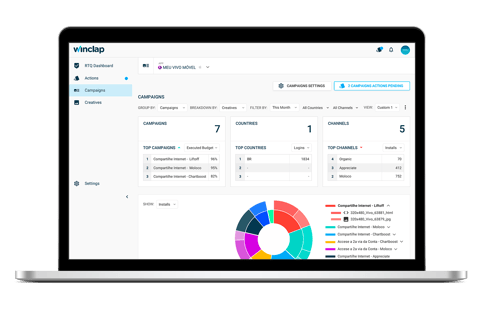After years building tech and knowledge working with the top digital advertisers in multiple verticals, Winclap is opening their platform through a cloud based service that will enable Advertisers from all around the world to leverage from its AI tech. We've interviewed Gonzalo Olmedo, co-founder and CSO at Winclap, to learn better about where they're going with this launch and what they want to achieve.

M- So, what is this new technology you are launching to the market? G- We noticed that Marketing, specially Mobile Marketing, is a crowded space. There are multiple tools, media sources and agencies that create a chaotic operation management for enterprise CMOs. CMOs and Marketing teams need simplicity in their internal processes. Since costs of acquiring new users are growing and organic uplift multipliers are decreasing, they need to execute flawlessly, and more importantly, they need to take better decisions than their competitors.
In order to do this, just to start, they need to break the silos that guard their data, and get all relevant data in the same UI, a massive challenge. And while this is crucial to understand the full marketing landscape (either using a self-built tool or a 3rd party solution), that’s only solving a portion of the problem. We’ve built artificial intelligence (AI) that helps them take better decisions with powerful insights. Our tech builds insights like how your creative assets will perform in the short term, or which color palettes, message and products will get you the optimal performance. Winclap notices when creatives lower the performance across multiple channels and predicts which is the optimal budget allocation between your media sources. Our tech learns if your competitor is improving its ranking in a given market, and if you need to invest more there, and how. Even more, we detect when organic users are being attributed to paid media, and when suspicious traffic is hitting your app after it was filtered by your fraud detection tool. We feed our AI with data from all relevant MMPs, Media Sources, Analytics tools, App Stores and other data platforms, and are able to turn raw data into highly accurate actionable insights. We are helping CMOs to manage investments in multiple geos, apps, languages and target customers.
M- How did you know that it was the right time to build this technology? G- The secret here is that we are not inventing some new complex strategy or a new ad-format or whatever new innovation happens in the market. We are translating the knowledge base from the most sophisticated CMOs in the market to an AI engine. This opens the door to flawless execution with more scale, better efficiency and better results. We’ve been some time in the market helping Advertisers manage their Media Buying using this tool internally, and have seen tremendous impact in their investment. We think the technology is mature now, and that we can open it up to advertisers all around the world. We knew this was the right time when we saw that getting the right insights on time were improving their ROI up to 40%, and simplifying their operation significantly. We decided to open this to the world because we believe this is the time to start building a more transparent and fair ecosystem, where advertisers have a full view of what they are investing in and helping them deploying that investment optimally.
M- What do you think are the main challenges for a CMO right now? G- It’s no news that this is a broken ecosystem. Fraud is still a huge problem, even with a lot of tools in the market, and it doesn’t seem to be slowing down. But more importantly, there are significant costs associated with making good marketing decisions. Detecting fraud is just one of those decisions. Just integrating data needs a lot of manual work, and hasn’t been totally solved by 3rd party tools. This results in teams having huge difficulties to get a deep understanding of what is really happening with their investment. Also, our clients were struggling with executing the right actions across multiple channels in different geos and with different product offerings. That’s why our AI made sense for them, in order to build actionable insights regarding their creative operation, budget allocation decisions, or their campaign optimization on a large scale. With these insights, their team could spend more time in the creative aspects of the product, and less in gathering data and building reports to understand what to optimize.
M- Why do you think marketers needed this? What is the difference with a traditional MMP. G- The Advertising ecosystem is broken. Plain simple. The multiplicity of tools, media sources, business models, agencies and non-sophisticated people creates a chaotic space where Advertisers are struggling to deploy marketing investments efficiently. We significantly lower the level of complexity, by providing a command center for Marketing teams, where they have all the relevant data and insights obtained from that data, and that helps them work collaboratively, resulting in a huge improvement in marketing efficiency. We are not an MMP, and are not planning to become one. There are great players in that market, most of them are our partners, and they've had tremendous growth in it. We offer the advertiser a different value. MMPs need to be unbiased, in a sense that they need to be really accurate in telling the Advertiser (and Media Source) what really happened, (i.e. User A viewed Impression X, clicked, installed and made a purchase). And they need to be really good at it, because attribution is a complex science that affects multiple players in the market. We are not unbiased. We tell the Advertiser how they should execute, and sometimes this means pausing the investment in a Media Source because that will result in an improvement in their KPIs. We act as an extension of the Advertiser’s marketing team.

